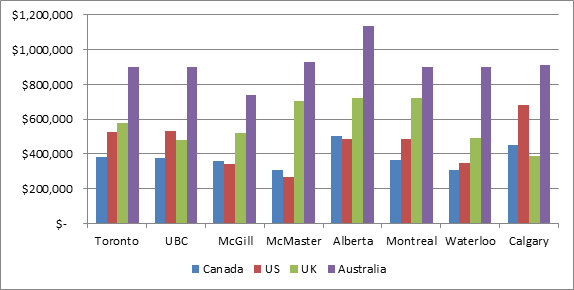It occurred to me while writing that last piece about salary comparisons: what if University Presidents used the same set of arguments about salary that professors do? What if we set their salaries as a function of what a comparator set of institutions were paying?
For this exercise, I have compared the presidential salaries at each of the top eight Canadian institutions in the Shanghai Academic Rankings of World Universities to those at the nearest comparator institutions among public universities in the United States, the United Kingdom, and Australia (for institutions outside the Top 100, where universities are grouped into bands of 50 or 100, I chose the “adjacent” institution by overall publication output). The resultant comparators are shown below.
Canadian Universities and Closest Comparators in ARWU Rankings
I took data for Presidential salaries from a variety of sources. For Canada, the data is from the ever-useful CAUT Almanac, except for l’Université de Montréal, which is from here. These don’t yield perfect comparisons; one notable issue is that Alberta reports total compensation rather than salary, which makes Indira Samarasekara’s compensation look significantly higher than her comparators, for whom only data on salary is provided. For the US, the data is from the Chronicle of Higher Education (via Berkeley to avoid the annoying paywall). UK data is from the Times Higher Education Supplement, and Australian data is from The Australian.
Figure 1: Salaries of Canadian University Presidents and Close Foreign Comparators
Here’s what we learn from Figure 1:
1) Man, oh man, oh man, being a Vice-chancellor in Australia is a sweet deal. Remember a few weeks ago when I asked why no Canadian institution had hired an Australian? Apparently the answer is, “we can’t afford them”.
2) There isn’t a straight line between university status and CEO pay in any country. It’s never the top school that pays its President the most.
3) In four of these comparisons, the Canadian President is the worst-paid among the comparators; in the other four, they’re the second-worst. This is somewhat different than the situation among full-time academic staff, where the wage gap tends to go in the other direction.
To be clear: I’m not suggesting our Presidents could use a raise. I’m simply pointing out that if Presidents used the same kind of arguments that faculty unions use to demand wage hikes, the data above could certainly be used to make a very persuasive case. Sauce for the goose, and all.
Maybe “what the guy down the road earns” isn’t the be-all-and-end-all for salary comparisons. Maybe we need some better benchmarks.



 Tweet this post
Tweet this post

One response to “If University Presidents had a Union”